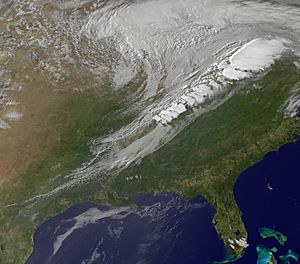Cold front facts for kids
A cold front is a weather term that describes what happens when a mass of cooler air moves into an area where the air is warmer. Imagine a big, heavy blanket of cold air pushing its way forward. Because cold air is more dense (heavier) than warm air, it slides underneath the lighter, warmer air, lifting it up.
This upward push of warm air can create clouds and cause different types of weather. You might see a line of showers, thunderstorms, or even a strong line of storms called a squall line, especially if there's a lot of moisture in the air. This lifting motion also causes the air pressure to drop along the front. Cold fronts can also move quite fast, sometimes twice as quickly as warm fronts.
What Happens When a Cold Front Arrives?
When a cold front moves in, the cooler, heavier air acts like a wedge. It slides right under the warmer, lighter air. This forces the warmer air to rise quickly into the atmosphere.
As the warm air rises, it cools down. This cooling causes the moisture in the air to condense, forming clouds. If there's enough moisture, these clouds can grow into showers or even powerful thunderstorms. This is why cold fronts often bring sudden changes in weather.
How to Spot a Cold Front on a Map
On weather maps, meteorologists use a special symbol to show where a cold front is. It looks like a blue line with blue triangles, or "spikes," pointing in the direction the front is moving. So, if the triangles are pointing east, the cold front is heading east. This symbol helps us understand how the weather might change in different areas.
Images for kids





